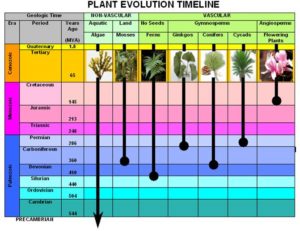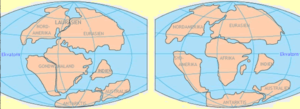Fish (World Wide because spread in oceans)
The evolution of fish began about 530 million years ago during the Cambrian explosion.
First plants on land (World Wide because evolved before continents split)
The first land plants appeared around 470 million years ago, during the Ordovician period

Insects on land (World Wide because evolved before continents split)
The first insects were land bound, but about 400 million years ago in the Devonian period one lineage of insects evolved flight, the first animals to do so
Amphibians (World Wide because evolved before continents split)
Amphibians evolved in specialized situations about 400 million years ago during Devonian period, when climate became warm and humid, and huge swamps and marshlands appeared on land. By Carboniferous period 360 million years ago there were dense gymnosperm forests all over the land areas. Advancement of forests on land attracted insects, worms and molluscs that had already achieved the capability to inhabit terrestrial forests and which were part of fish and amphibian diet.
Reptiles (World Wide because evolved before continents split)
Reptiles evolved from amphibians of Carboniferous period,360 million years ago which depended on water bodies for laying eggs and development of larval stages and hence could not exploit arid habitats far away from water bodies. They invented a large yolk-laden shelled egg that could be laid on land
Birds (World Wide because evolved before continents split)
birds and modern reptiles, which are believed to have split about 315 million
Birds are most closely related to crocodiles. To understand this, we should look at some history. The first groups of reptiles evolved about 300 million years ago. About 40 million years later,, a group of reptiles called therapsids branched off, which eventually became modern mammals. Other groups of reptiles split off over the next 120 million years, and one branch called the dinosaurs were very successful. These dinosaurs were only distantly related to modern snakes, lizards, and turtles, groups that had split off at different times. But 65 million years ago there was a massive extinction event, and all dinosaurs were killed except for a single group of feathered dinosaurs. These evolved over the next 65 million years into modern birds. So birds aren’t just closely related to dinosaurs, they really are dinosaurs
Monotremes (Confined to Australasia)
When the common ancestor of mammals from ≈225 million years ago split into monotremes, marsupials, and placental mammals, egg laying was retained in monotremes and lost in all other mammals.
Monotremes once dominated Australia, until their pouch-bearing cousins, the marsupials, invaded the land down under 71 million to 54 million years ago and swept them away. New research suggests these two kinds of creatures managed to survive because their ancestors took to the water.echidnas diverged from platypuses only 19 million to 48 million years ago, meaning that echidnas recently had semiaquatic ancestors and only later recolonized the land.
Marsupials ( Confined to Australasia, South and North America.)
Marsupials (Metatherians) are thought to have evolved, along with placental (Eutherian) mammals, from Therian mammals.
Marsupials diverged from Eutherian mammals approximately 90 million years ago.
Marsupials probably evolved in North America, expanded into South America and the Pacific rim of Asia.Marsupials began to migrate to Australia and New Zealand from North America in the late Cretaceous or early Tertiary period. The route of migration crossed Antarctica and into Australia. As Australia broke off from Antarctica and moved northwards, its isolation from other landmasses was complete and the independent evolution of marsupials in Australia and New Zealand began. During this period of migration the North American marsupials became extinct, followed by extinctions in Europe during the Miocene epoch of the Tertiary period.
When North and South America rejoined in the Pleio-pleistocene, South American marsupials migrated back into North America, where Didelphis virginiana, the American opossum evolved.
Placental mammals.(Varied Distribution due to Continents being separated prior to evolution.)
The first placental mammals appeared at the beginning of the Cretaceous period.145 million years ago The earliest mammals were tiny, shrew-like mammals.
About 100 million years ago Laurasia was the northern continent and Gondwana was the southern continent.
Mammals from the northern continent Boreoeutheria (“northern true / placental mammals”)
Laurasia
(hedgehogs, gymnures)(moles, shrews, solenodons)(camels and llamas, pigs and peccaries, ruminants, whales and hippos)(pangolins)(bats)(cats, dogs, bears, seals)(horses, rhinos, tapirs).
Euarchontoglires
(rabbits, hares, pikas)(mice and rats, squirrels, porcupines)(tree shrews)(colugos)(tarsiers, lemurs, monkeys, apes including humans)
Euarchontoglires probably split from the Laurasiatheria sister group about 85 to 95 million years ago, during the Cretaceous, and developed in the Laurasian island group that would later become Europe.
Mammals from the southern continent (Atlantogenata , born round the Atlantic ocean”)
South america (armadillos, anteaters, sloths)
Africa (Afrotheria)(golden moles, tenrecs, otter shrews)(elephant shrews)(aardvarks)
(hyraxes)(elephants)(manatees, dugongs)
This goes a long way to explaining wildlife distribution
Big cats
about 6 million years ago
It appears the tibetan Plateau was a center of origin of a whole slew of animals that subsequently spread across Eurasia during the cold periods of the ice ages. During that time the Plateau was always cold,so animals that evolved there were preadapted to the climate of the ice ages, and this facilitated their spread.
Dogs
Grey wolves most likely originated in Asia. over a million years ago It probably took up residence in North America some 700,000 years ago, after having crossed the Pleistocene land bridge which connected the two continents at that time.
Bears
Grizzly bears as we know them originated in Asia around 1.3 million years ago, evolved from Etruscan bears that appeared in Europe about 5 million years before. Brown bears (Ursus arctos) crossed the Bering land bridge some 200,000 years ago. These bears eventually developed into the grizzly bear.
Primates
Spread from over 100 million years ago across what is now Asia, Africa and South America.
